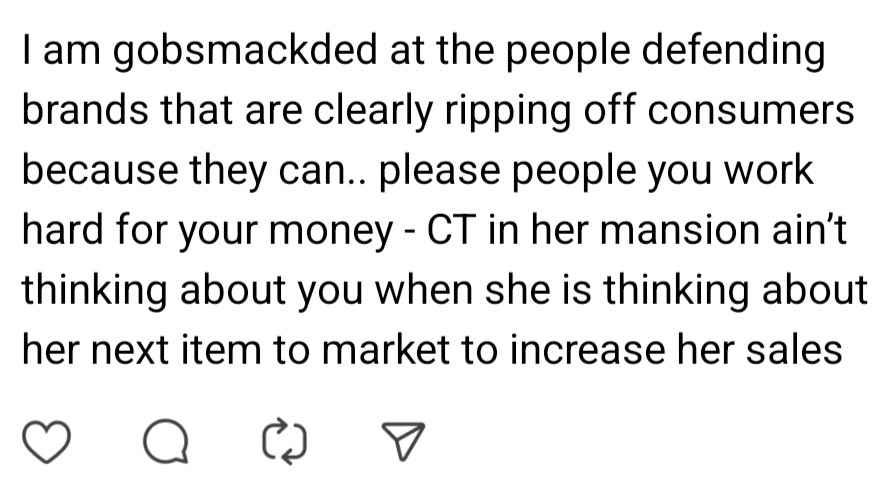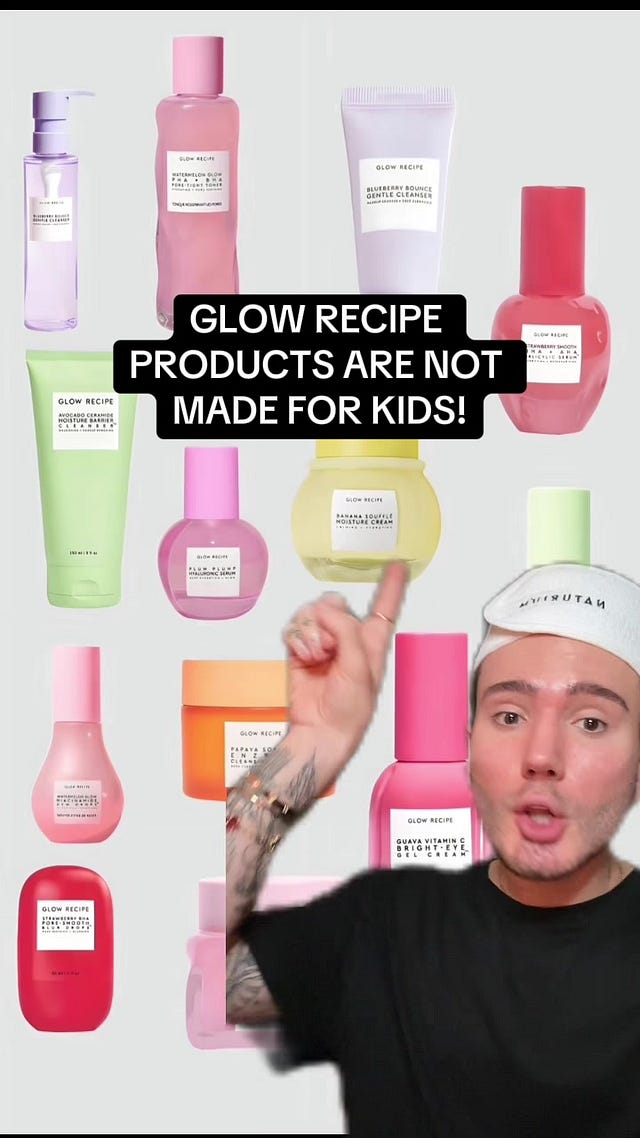Skincare dupes, the cost of living crisis and consumerism
The love-hate triangle that's all about money and reputation. But, who's really at a loss here?
The cost of living is fucked and it’s affecting the way we consume skincare and beauty products. That is a fact.
I wouldn’t be surprised if there is a correlation between the number of skincare dupes in the market and the increase in the cost of living (and therefore the price of skincare). But, how far is too far?
I will be honest, when I went to Target and saw a dupe of Glow Recipe’s watermelon serum, I was shocked. It was beyond inspiration, there was no hiding that it was intended to be an exact duplication.
But am I mad? Well, it’s complicated. There’s more at play than a duping issue. Dupes have always existed and there’s so much underneath the surface than picking a side of being outraged or nonchalant about product dupes. Let’s go through some ideas.
“As close as it can be.”
Firstly, the news making waves. With MCoBeauty opening its audience to the US market, the brand’s business model has recently been the angle for many articles the ABC has covered (read here, here and here), specifically on their tricks of the trade on duping high-end products.
Duping products has become an art for the brand, with MCobeauty CEO Shelley Sullivan saying that they strive for the dupes to be “…as close as it can be.” But a question pops to mind: If the dupes are "as close as it can be” to their hundreds of dollars counterparts, what is the rest of the money going towards? Hilary Holmes from Holme Beauty expressed her opinion in an Instagram story, saying “they can make it cheaper because they haven’t done the development work.”
It’s a double-edged sword. Affordable alternative products are not a new idea and aren’t as common nor are they sought out as much comparitively. It’s also suggested that dupes don’t work as well as the original product. So, what’s going on?
The initial reaction
The outrage is loud on social media, and as it should be. Consumers are passionate about brands and they love being copied by a brand. People's ideas and creativities are being stolen and the legal aspect is not protecting their products enough.
I love this perspective from Sam By The Counter, who’s explained clearly that there’s a difference in what MCoBeauty is doing. They’re not just a duping brand. They’re also a brand that has been sued twice for their actions.
It’s the intention of MCoBeauty that is more shocking rather than anything else. How are they swerving around copyright law and the intellectual property of other brands?
Accessibility to skincare
With the news that’s occurring, we shouldn’t expect or force others to stop buying MCobeauty (or other duping brands), as they appeal to an audience that others cannot afford. There are other options, sure, but genuinely it’s not enough. Affordable alternatives are still uncommon in the industry, and therefore the consumer shouldn’t be downgraded.
There is so little in the low-cost beauty market. Accessibility is still an issue. The last thing someone has on their mind in this state of their life is how Norvina or Charlotte Tilbury is going to react, as described by a Threads comment I saw below:
(Important to note: in 2019, Charlotte Tilbury won a lawsuit against Aldi regarding a dupe of her product.)
Nevertheless, as a ‘fuck capitalism’ kinda gal, it’s a valid stance. Anyone who’s in or has been in a low socio-economic status knows exactly what it’s like not to have the ability to access something that everyone else seemingly owns. Beyond beauty, it can be clothing, food, or even access to basic housing.
So, is the MCoBeauty reputation tarnishing the market for affordable products? The conversation of dupe brands brings us to a fine line. We don’t want to assume that every low-cost beauty brand is an alternative/dupe brand.
Are we devaluing what consumers want? Do consumers really want a dupe of the Niacinamide Dew Drops from Glow Recipe, or do they simply want a good niacinamide serum?
Psychology of the marketing strategy of duping
MCoBeauty thrives on its duping marketing strategy. When people see a pattern or something that easily identifies a brand they automatically have a feeling or reputation towards that brand.
If consumers have a great feeling towards Ultraviolette’s sunscreens, that would be a good indication of a brand to dupe their products. The link between the brand and consumer is already there.
It’s not necessarily the product or the imitation of the ingredients formulation that people are outraged about. It’s the copying of the packaging, the marketing and the branding that people are visually seeing. They’re riding on the reputation that someone else has created.
The dupes are great, let’s be honest. The outrage has to occur if it is a good product. No one would care if they had a similar packaging style and the product itself was shit. But the practices are pushing the boundary too far.
Tween skincare
The discussion of tweens using high-end brands through social media influence has been well-saturated and well-documented. It’s another topic with many layers, especially how brands react to it.
Glow Recipe, despite its cute and playful packaging, is not cheap. But, it’s a hit for younger shoppers, regardless if they’re suitable for the product.
In this case, I’d rather see tweens use the MCoBeauty’s Glow Recipe dupes than see them use the actual Glow Recipe product. I’m not exactly sure why there is an infatuation of children buying high-end products, but it’s a very uncomfortable situation.
Aftermath of COVID-19
A year ago, skincare brands were posting their price increase announcements. It was all in the name of honesty, being candid with their consumers, and … It’s true. The aftermath of COVID-19 has seen some deaths of beloved brands due to the high costs.
So, what happens if consumers can’t afford them now?
Comparison to the fashion industry
Shein is a powerhouse of wage theft, dangerous working conditions and overall poor sustainability choices. The juggernaut is also well-known for ripping off fashion trends and smaller fashion designers.
It might be slightly unfair to compare the two. McoBeauty is obviously not as big as Shein (and is committing fewer crimes, not to mention we don’t know their working conditions, either) but you can see the reason for comparison: McoBeauty typically dupes the high-end brands: Glossier’s Cloud Paint, Ultraviolette’s sunscreens, etc. but what happens when a dupe brand rips off a smaller skincare brand? It’s the same, unethical practice as Shein.
The fashion industry also sees a lot of waste, largely from micro-trends. The beauty industry also goes through micro trends the same way coffee goes through my body. Strawberry makeup, latte makeup, boyfriend blush. In a way, dupes accentuate these micro-trends and push out products rapidly but what happens when these micro-trends are done? Well, I actually don’t know. Do micro-trends increase waste for the beauty industry like it does in fashion? Tell me!
Last thoughts
I empathise with brands whose products are being copied, especially beyond what can legally protect them.
But I also empathise with people who normally cannot access these types of products. With groceries, rent and everything else being so expensive, why must the lower class always be in the jaws of any issue? We lose, regardless.
Yes, McoBeauty’s business model with exact duping goes too far. Make no mistake, this is not a defence piece.
Classism, consumerism and the cost of living all influence this conversation.









This was such a good read!